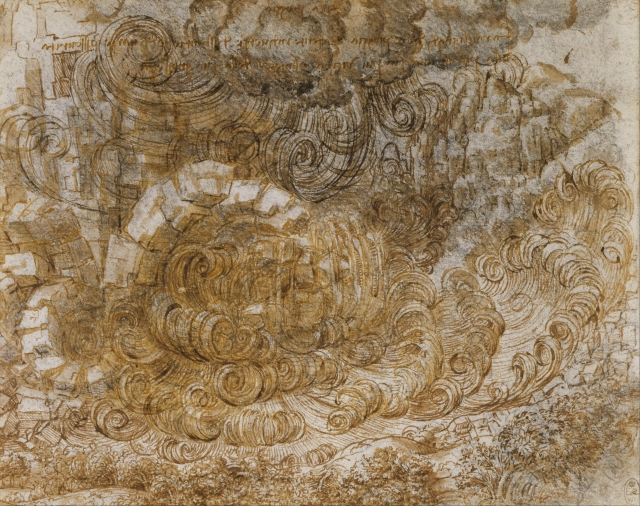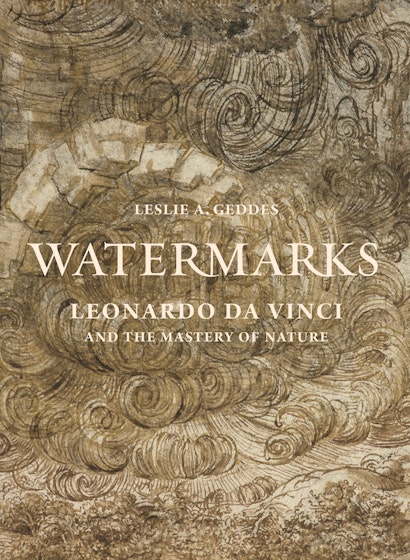Formless, mutable, transparent: the element of water posed major challenges for the visual artists of the Renaissance. To the engineers of the era, water represented a force that could be harnessed for human industry but was equally possessed of formidable destructive power. For Leonardo da Vinci, water was an enduring fascination, appearing in myriad forms throughout his work. In Watermarks, Leslie Geddes explores the extraordinary range of Leonardo’s interest in water and shows how artworks by him and his peers contributed to hydraulic engineering and the construction of large river and canal systems.
How did you come to write a book about Leonardo da Vinci?
LG: I started my research interested by a couple of interrelated questions that brought me to him. I was working on renaissance fountains at first, which are marvelous sculptural as well as architectural objects. And I was interested in villa design, which includes thinking practically about farming and irrigation and so forth, which got me thinking about large-scale land development. Let me put it this way: you want to examine how villas were designed and functioned? You need to think about water as the sculptor of landscape and the engine that keeps a villa running.
But I also really wanted to examine water as a subject in painting. Rendering water convincingly posed one of the trickiest challenges for a renaissance painter. So, amidst these questions about the practicalities of hydrological resource management and art making, I kept encountering one figure who turns his mind to its every aspect, and that person is Leonardo.
Like water finds its way through varying paths to its outlet, I found myself returning to Leonardo for every topic I was interested in—the practice of drawing, engineering technologies, hydrology, architecture, painting. In him, remarkably, you see every concern early modern artists and engineers had with water as a subject in art and as a technological problem.
Why research his peculiar fascination with water?
LG: Water is the thread that wends its way through every aspect of his work, artistic or scientific. It applied to the pragmatics of infrastructure from commerce to military defense. My book’s argument is, in part, that Leonardo’s interest was shared and indeed a vital topic of study and practical application. Water management was enormously important and a costly business. Lots of folks were working on related problems, and some of them were his collaborators, such as key figures of the era like Francesco di Giorgio and Donato Bramante. These artist-engineers were asking similar questions and working through solutions to these challenges.
Bear in mind that Leonardo mostly occupied his time as a military consultant. Painting had his heart, but his patrons… They wanted his practical expertise and engineering acumen. They wanted his machine designs. And yeah, okay, his paintings too.
Materially, water is absolutely essential in artmaking. Simply put, the artist’s task is to control the viscosity of pigments (oil or water based) on a support (wood panel, plastered wall, or paper). For all these reasons, Leonardo found himself drawn to exploring water’s elemental characteristics, dreaming up better ways to corral and channel it, observing the roughened banks of streams to intuit how it’s the main driver of nature, and striving to render it accurately in his paintings.
Before we get to the paintings: What machines did he invent?
LG: I’m going to dismantle that question a bit. Remember what I said about Leonardo not being unique in his interests? Everyone was concerned with water: the Arno River was famously unnavigable in places and flooding wasn’t uncommon. When you start looking at his designs for water machines—mechanisms for dredging silt from muddied canals, pumps to excavate water from the earth, even flotation devices—you realize that he’s relying on ancient and medieval technologies. A lot of the machines are mentioned by Vitruvius, for example. So what’s new or most significant isn’t necessarily his designs, it’s how he designed. How he drew. Drawing was his greatest technology.
You’re going to need to explain that bit. How exactly is drawing a technology?
LG: Of course, Leonardo didn’t invent drawing or writing, or even the tools you use to do so. He used pen and ink and sometimes red or black chalk on paper. But how he drew… that’s singular. That’s where Leonardo’s fame lies. He deftly adapted all these new and nimble graphic conventions to show machine components and those parts in action. The task of drawing a machine is both to demonstrate its parts and its function. The first half of my book is really about those drawing strategies. How Leonardo thought on paper, worked out ideas, and expressed them.
So how do we get from water machines to water in his paintings?
LG: By drawing, easily enough! The Italian term for drawing is functionally the same as in English: disegno references both the act of drawing and the product (a drawing). Disegno also relates conceptually to design, and that aspect of drafting—the intelligence informing the manual practice—underpins Florentine art theory and indeed all of Leonardo’s graphic work.
In Watermarks, I examine each drawing, whatever the subjects expressed, by seeking to identify what problems Leonardo and his peers were trying to solve. (In my opinion, it’s a great heuristic for approaching the study of old master drawings, period; identify the problem, and you’re halfway there to interpreting what you see on a page.)
There are loads of drawings based on his observation of nature. He made these exceptionally beautiful, minute drawings of the Adda River, for example. And lots of expressive studies of rock formations. Why? Well, when you look closely at them, you start to see his mind at work. He’s thinking about, for instance, how water shapes the edges of rivers, how it cuts into embankments, or how rocks are formed over eons through slow wear by water or swiftly through rupture via the released pressure of underground springs. And those observations fuel his paintings, where the natural elements are key to the religious sentiments expressed in those works.
He sought to represent nature in its purest form, and his paintings synthesize these ideas. I take particular delight in the stupendous landscape background of the Mona Lisa and the damp caverns of the Virgin of the Rocks. And of course, Leonardo, that inveterate experimenter, was also thoroughly preoccupied with the possibilities of oil paint and glazes. He’s seeking to mimic the exquisite translucency of water. We see that in his contributions to his teacher Andrea Verrocchio’s Baptism of Christ. It’s the first painting where we see him explore these themes which will carry him through his entire life.
Given ongoing water crises and related ecological threats today, what do you think we can learn from Leonardo?
LG: I think about the corrosive lead pipes in Flint, Michigan and related environmental crises in my own backyard. There’s Cancer Alley, a toxic 85-mile expanse of refineries along the Mississippi River, and Gordon Plaza, a Superfund site of appalling toxicity in New Orleans. And of course, the ongoing challenges of flood protection in the event of future hurricanes. I’ve never been so conscious of the perils of water and manmade interventions until I moved to the Gulf South.
Leonardo’s extraordinary output makes an unequivocal case for the necessity of art in conjunction with science. We are talking about visualizing problems of astonishing complexity. Image and text are still essential tools for the expression and communication of ideas. Leonardo’s study of water is marked by his desire to give shape to knowledge, to chart what couldn’t be readily perceived and understood, to represent action of a magnitude beyond human perception, to imagine vantage points not yet obtained. What better model for today than his persistent, inventive efforts to do so?
Leslie A. Geddes is assistant professor of art history at Tulane University.

